Question
In deciding on performance measures, organizations need to consider which of the following: Question 1 options: The objectivity of the measure The completeness of the
In deciding on performance measures, organizations need to consider which of the following:
Question 1 options:
| The objectivity of the measure | |
| The completeness of the measure | |
| The responsiveness of the measure | |
| All of the above | |
| None of the above |
Question 2 (1 point)
All of the following are guidelines for managing cross-functional teams except:
Question 2 options:
| Seek to create a critical mass of leadership. | |
| Train members in teamwork and process management. | |
| Get early involvement from all functional areas. | |
| Encourage team members to stay within their functional roles. | |
| Clarify expectations within and between teams. |
Question 3 (1 point)
An organization that tries to increase compliance with rules about conserving supplies by locking the supply closet is using which compliance strategy?
Question 3 options:
| Preventative similar to putting hurdles up in front of employees | |
| Punitive similar to threatening employees with sticks | |
| Cognitive similar to enlightening employees about the benefits of compliance | |
| Remunerative similar to tempting employees with carrots |
Question 4 (1 point)
When prioritizing tasks, what two characteristics are important for you to identify according to Steven Covey?
Question 4 options:
| How urgent it is to act on the task and how important the task is | |
| How important the task is and whether someone else is available to complete the task | |
| Whether the task is internally- or externally-focused | |
| How long the task will take to complete and how important the task is |
Question 5 (1 point)
Which of the following is NOT a key paradox that managers often face when they try to maintain tight controls in the organization?
Question 5 options:
| Employees who are frustrated by tight controls may choose to leave the organization, reducing stability | |
| Leaders who exert tight controls are often more effective at higher levels of the organization than at lower levels. | |
| By stifling creativity, tight controls can result in lower profits which then reduces that ability of the organization to survive. | |
| Tight controls and rules to improve organizational effectiveness can become impediments to individual performance. |
Step by Step Solution
There are 3 Steps involved in it
Step: 1

Get Instant Access to Expert-Tailored Solutions
See step-by-step solutions with expert insights and AI powered tools for academic success
Step: 2

Step: 3

Ace Your Homework with AI
Get the answers you need in no time with our AI-driven, step-by-step assistance
Get Started


